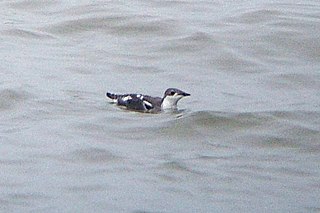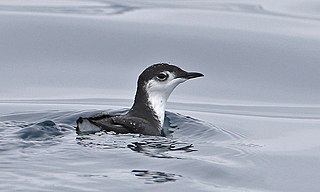Xantus's murrelet, native to the California Current system, has been split into two species:
- Scripps's murrelet, Synthliboramphus scrippsi
- Guadalupe murrelet, Synthliboramphus hypoleucus
Xantus's murrelet, native to the California Current system, has been split into two species:

An auk or alcid is a bird of the family Alcidae in the order Charadriiformes. The alcid family includes the murres, guillemots, auklets, puffins, and murrelets. The word auk is derived from Icelandic álka, from Old Norse alka (“auk”), from Proto-Germanic *alkǭ.

The ancient murrelet is a bird in the auk family. The genus name Synthliboramphus is from Ancient Greek sunthlibo, "to compress", and rhamphos, "bill", and antiquus is Latin for ancient. The English term "murrelet" is a diminutive of "murre", a word of uncertain origins, but which may imitate the call of the common guillemot. Ancient murrelets are called "ancient" because they have grey on the back like a shawl, as worn by the elderly.

John Xantus de Vesey a.k.a. de Csíktaplócza was a Hungarian exile and zoologist. Xantus was born Xántus János, in Csokonya, Somogy, Hungary.

The marbled murrelet is a small seabird from the North Pacific. It is a member of the auk family. It nests in old-growth forests or on the ground at higher latitudes where trees cannot grow. Its habit of nesting in trees was suspected but not documented until a tree-climber found a chick in 1974, making it one of the last North American bird species to have its nest described. The marbled murrelet has declined in number since humans began logging its nest trees in the latter half of the 19th century. The decline of the marbled murrelet and its association with old-growth forests, at least in the southern part of its range, have made it a flagship species in the forest preservation movement. In Canada and Alaska, the declines are not so obvious because populations are much larger and the survey techniques have not had sufficient power to detect changes.

The long-billed murrelet is a small seabird from the North Pacific. The genus name Brachyramphus is from Ancient Greek brakhus, "short", and rhamphos, "bill". The species name perdix is Latin for "partridge" Pallas described this auk as Magnitudine Perdicis. "Murrelet" is a diminutive of "murre", a word of uncertain origins, but which may imitate the call of the common guillemot.

The Guadalupe murrelet is a small seabird found in the California Current system in the Pacific Ocean. This auk breeds on islands off California and Mexico. It is threatened by predators introduced to its breeding colonies and by oil spills.

Kittlitz's murrelet is a small alcid found in the waters off Alaska and Eastern Siberia. This near threatened species is, like the closely related marbled murrelet, unusual for seabirds in not being colonial, nesting instead in isolated locations on mountain tops, where the nests were known to Native Americans for many years before skeptical ornithologists described and photographed them. It is a poorly known and little studied species, although concern over its status and that of the closely related marbled murrelet has led to a recent increase in research.

The Japanese murrelet or crested murrelet is a small bird that inhabits rocky islets and reefs in the warm waters of Japan and southern Korea. Its non breeding range includes Hokkaido and southern parts of Primorye and Sakhalin. It has black and bluish grey upper body and white underparts plumage.

Craveri's murrelet is a small seabird which breeds on offshore islands in both the Pacific Ocean and the Gulf of California off the Baja peninsula of Mexico. It also wanders fairly regularly as far as central California in the US, primarily during post-breeding dispersal. It is threatened by predators introduced to its breeding colonies, by oil spills, and by tanker traffic. Increasing tourism development and commercial fishing fleets also further threaten the species. With an estimated population of 6,000-10,000 breeding pairs, its population is listed as vulnerable.

Brachyramphus is a small genus of seabirds from the North Pacific. Brachyramphus is from Ancient Greek brakhus, "short", and rhamphos, "bill". The species are named as "murrelets"; this is a diminutive of "murre", a word of uncertain origins, but which may imitate the call of the common guillemot.

Synthliboramphus is a small genus of seabirds in the auk family from the North Pacific. The genus name Synthliboramphus is from Ancient Greek sunthlibo, "to compress", and rhamphos, "bill". "Murrelet" is a diminutive of "murre", a word of uncertain origins, but which may imitate the call of the common guillemot.

USS Murrelet (AM-372) was an Auk-class minesweeper acquired by the United States Navy to remove mines from minefields laid to prevent ships from passing. She was the only U.S. Navy ship named for the murrelet, a small sea bird found chiefly on islands in the northern Pacific Ocean.

Willapa National Wildlife Refuge is a National Wildlife Refuge located on the shores of Willapa Bay in Washington, United States. It comprises 11,000 acres (45 km2) of sand dunes, sand beaches, mudflats, grasslands, saltwater and freshwater marshes, and coniferous forest. The refuge includes Long Island with stands of old growth Western red cedar and hemlock.

Laurens Theodoor Gronovius, also known as Laurentius Theodorus Gronovius or as Laurens Theodoor Gronow, was a Dutch naturalist born in Leiden. He was the son of botanist Jan Frederik Gronovius (1686–1762).

Scripps's murrelet is a small seabird found in the California Current system in the Pacific Ocean. This auk breeds on islands off California and Mexico. It is threatened by predators introduced to its breeding colonies and by oil spills.

Federico Craveri was an Italian explorer, ethnographer, geologist, meteorologist and naturalist noted for his studies in Mexico.

Scott Islands Marine National Wildlife Area is a National Wildlife Area off the northwestern tip of Vancouver Island in British Columbia, Canada. Covering an area of 11,570.65 km (7,189.67 mi), it is the second largest protected area in British Columbia after Offshore Pacific Seamounts and Vents Closure and is the largest national wildlife area in Canada.